Lahti 作者: 来源: 发布时间:2021-10-16
一、所属省或是州,具体位置,人口,面积
Lahti is a city and municipality in Finland. It is the capital of the region of Päijänne Tavastia (Päijät-Häme) and its growing region is one of the main economic hubs of Finland. Lahti is situated on a bay at the southern end of Lake Vesijärvi about 100 kilometers (60 mi) north-east of the capital Helsinki. It is also situated at the intersection of Highway 4 (between Helsinki and Jyväskylä) and Highway 12 (between Tampere and Kouvola), which are the most significant main roads of Lahti.
In English, the Finnish word Lahti literally means bay. Lahti is also dubbed the "Chicago of Finland" due to the premise of both cities when they were known as "Slaughterhouse cities". Also, the Troubled history of both cities in the field of crime has been seen as one of the similarities. The coat of arms of the city depicts a train wheel surrounded by flames.
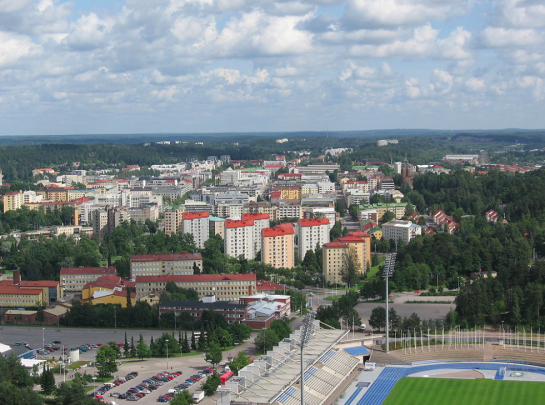
二、自然地理
1.地理条件
The Salpausselkä ridge with its hills as well as countless Lakes are representative views of the city. The biggest lake is Vesijärvi which is also a gateway to central Finland. Lahti is located on the southern shore of Lake Vesijärvi, which belongs to the Kymijoki watershed. The first Latch Back passes through the city. The headwaters of the Porvoonjoki River are on the southern slopes of Salpausselä, and the upper reaches of the river run through the southern parts of the city. The town is characterized by the hillyness of Salpausselä and numerous lakes. Vesijärvi forms a gateway to central Finland via Päijänne. Häme dialects are spoken in Lahti.
At the end of 2018, Lahti had 119,951 inhabitants, of whom 115,752 lived in urban areas, 2,912 in sparsely populated areas and the coordinates of the place of residence of 1,287 inhabitants were unknown. The degree of agglomeration is calculated for those residents whose coordinates of residence are known; The degree of agglomeration in Lahti is 97.5%.
2.交通情况
The city is served by 20 local bus lines, most of which are pendulum lines between two different areas via city centre. Bus transport in the Päijänne Tavastia region is organised by the regional transportation authority, known as Lahden seudun liikenne or LSL, and run by several private companies which have bid for the right to run their lines. LSL buses cover all urban areas at 10–20 minute intervals and most nearby municipalities at 30–60 minute intervals.
Lahti is served by VR commuter rail, the Z train to Helsinki and the G train to Riihimäki run hourly. Most services to Kouvola don't have a letter designation and are run every three hours aside from rush hours. There are plans for building two new train stops inside the city limits before 2020, Hennala and Karisto. A local service to Heinola has been proposed but renovating the old line has been deemed too expensive and unprofitable in the long term, unless the Finnish state reaches an agreement with regional councils to finance a direct rail link from Lahti to either Jyväskylä or Mikkeli.
Bus station, built in 1939 and designed by architect Kaarlo Könönen.
The city's main transportation hubs are the market square (Kauppatori) and the travel centre (Matkakeskus), with local buses providing a non-stop service between the two. The travel centre was built between 2014 and 2016 around the Lahti railway station by building new local bus stops around the station, a long-distance bus terminal next to the station building and an automated parking facility for commuters.
All local and long-distance trains and buses stop at the travel centre, making it convenient to transfer from one mode of transport to another. The city council has sold the old bus station in the city centre and it will be redeveloped for other uses in the near future.
三、经济发展和规模
The economic region of Lahti, which includes the surrounding municipalities, was strongly affected by the Collapse of Finnish-Soviet trade and by the recession in the early 1990s. The value of production is slumped, especially in the mechanical engineering industry and other manufacturing industries (e.g. the furniture industry). Production also decreased in the textile and clothing industry. In 1990, there were 90,370 jobs in the Lahti region. The number of jobs diminished over the next couple of years, so that in 1993 there were fewer than 70,000 jobs in the region. The number of jobs had slowly increased to 79,138 in 1999.

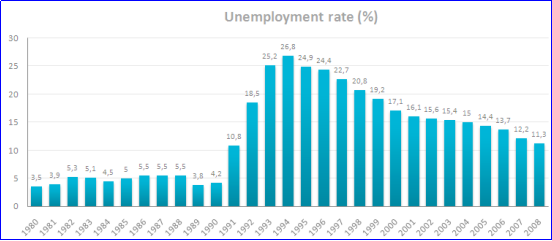
In 1995, R&D expenditure was FIM 715 per person, while Finland's average was about FIM 2050. The amount of Tekes (the National Technology Agency) funding in the Lahti Region grew 40% during 2004–2007 while the average growth in Finland was 60% .

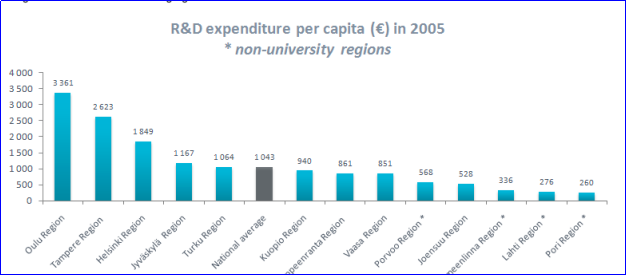
四、产业特点/重点项目
For a long time, Lahti, like Pori, was a city of workers, which became a declining industrial place for years. The bay was heavily relocated for a long time until the industry began to decline. However, demographic trends have again been mostly upward in the 21st century.
During the recession, a lot of jobs left the Lahti industry. The city suffered from severe unemployment during the recession years.
Lahti belongs in practice to the Helsinki metropolitan area, because the growth of the Helsinki metropolitan area radiates to Lahti. The Helsinki – Lahti motorway and the Lahti straight line are connected to the same entity. Since the mid-2000s, shrinking travel time in the direction of Helsinki has produced results and employment in the Helsinki metropolitan area and from there to Lahti has increased considerably.
Lahti and the Lahti region offer a relatively central location for manufacturing and logistics in southern Finland. Sectors include the consumer goods and food industries. The location in Lahti is an advantage when transporting goods outside the Helsinki metropolitan area. Transport journeys to other parts of Finland are on average shorter from Lahti than from the Helsinki metropolitan area. After Hartwall bought the brewing company Mallasjuoman, it founded a large brewery in Lahti. Is Hartwall Brewery the most significant source of influence nationwide? Bay-based function. High-quality water is easily available in Lahti and its location is central in southern Finland. The brewing traditions of Malt Drink are also significant.
Compared to several other Finnish cities, Lahti has few government jobs. Lahti and Päijät-Häme are significant net contributors to the state. The situation has been balanced by the fact that the state has diversified its investment in ARA (formerly the State Housing Fund) in Lahti.
Since the recession, the Finnish state has made important investments for Lahti. From Helsinki and through Lahti to Heinola Lusi, there is a motorway and from Kerava to Lahti. The state has also supported the construction of the Sibelius House and the renovation of the Sports Center.
Much of Lahti's future expectations are based on transit traffic - on how well the city and its neighboring areas are able to benefit from the state's extensive short-distance investment and to attach to the Helsinki metropolitan area.
After the 1990s, civic movements independent of council parties began to form in Lahti-based municipal life in the fields of nature conservation, renovation of the school network and sports facilities.
Such a movement is, among other things, Salpausselän Luonnonystävät ry, which has been organized as an association. The association intervenes in development projects that it has identified that are problematic from the point of view of environmental legislation. The association has also been criticized for justifying some complaints.
The Kujala logistics center is located on the lands of the former Kujala Agricultural School. The first phase of the Kujala logistics center was completed in 2010.
A Nostava logistics center is planned in the Lahti region, located in the neighboring municipality of Hollola. In the Lahti region, new logistics operations have also been concentrated south of the Lahti city border and Renkomäki, in Orimattila's Pennala.
The Trio shopping center is the largest shopping center in Päijät-Häme. In recent decades, the commercial focus of Lahti city center has shifted from the Kauppatori area to the east. At the end of Aleksanterinkatu, a large shopping center complex was formed in the 1990s, when three Alex commercial buildings were merged into the Trio shopping center. The Hansa commercial building along Kauppakatu was also connected to the trio. At the turn of the millennium, the Syke shopping center was built in Raute's former factory block.
A few smaller pedestrian areas have been built in the center of Lahti. The section of Rautatienkatu between Vapaudenkatu and Hämeenkatu has been transformed into a pedestrian street. The pedestrian section of Rautatienkatu between Aleksanteri and Vapaudenkatu is called Lanunaukio.
The shops in the city center compete for customers with Laune hypermarkets, which were built in the early 1990s. Efforts have been made to enliven the city center by, among other things, hiring a central host, whose task has been to organize events in the city center and develop the centre's marketing. In order to maintain operations, the Lahti City Center Association was established in 1999, now Lahti City Association. Beneath the Lahti market square is a parking garage for almost 600 cars, a market park that started operating in May 2015.
五、风景名胜,景点
1. Lahti City Library
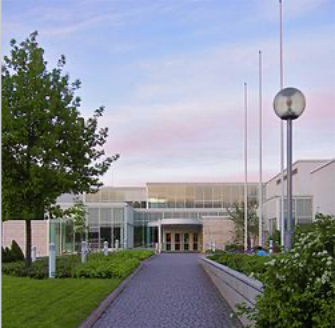
Lahti City Library is a public library maintained by the City of Lahti. In the Lahti city area, in addition to the main library, the residents are served by the local libraries of Ahtiala, Jalkaranta, Kärpänen, Laune, Liipola, Mukkula, Renkomäki and Nastola, as well as the library cars Pegasos and Eepos, which run in the former Nastola municipality.
The Lahti City Library, together with other libraries in Päijät-Häme, has served the common website since December 2013. In May 2018, a new, joint material database Lastu-Finna was opened
2.Lahti City Theater
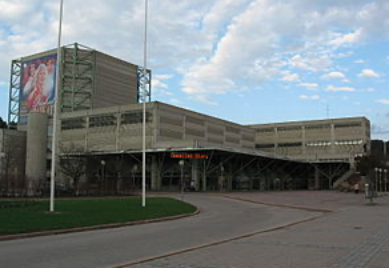
Lahti City Theater is a Finnish professional theater. The theater is visited by less than 70,000 spectators a year. The theater produces 7-10 new plays every year. Lahti Theater House is the current theater building of the Lahti City Theater, completed in 1983. It is located near the center of Lahti on Kirkkokatu. The design of the building began in the early 1970s with an architectural competition and construction work began in the autumn of 1980. The main designer of the house was Pekka Salminen Ky Architects. The Theater House won the Concrete Structure of the Year competition in 1982. The official inauguration was on September 10, 1983.
The house has three stages: the large Juhani stage (653 people), the small Eero stage (250–290 people) and the studio stage Aino (81 people). The building has a volume of about 80,000 m3 and a floor area of about 12,000 m2
3. Church of the Cross
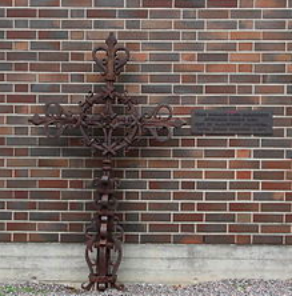
The Church of the Cross is the main church in Lahti and the parish church in Central Lahti. The modernist church, completed in 1978, is one of the most recent works by architect Alvar Aalto.
The Church of the Cross is centrally located in Kolkanmäki. It rises at the north end of Mariankatu, which runs north-south through the center of Lahti, and its tower reaches a height of 40 meters above the ground. At the southern end of the same street, on the ridge of Salpausselä, is the town hall designed by Eliel Saarinen, and in the middle of the church and town hall is the Lahti market square.
The site was a wooden church in Central Lahti, previously built in 1890, designed by architect Albert Mellin. The wooden church proved to be too small already in the 1920s, and its appearance was not considered suitable for the developing cityscape either. As early as the 1930s, preparations began for the acquisition of a new church to replace or coexist with the Central Lahti Church.
六、历史文化
1.历史
Lahti was first mentioned in documents in 1445. The village belonged to the Parish of Hollola and was located at the medieval trade route of Ylinen Viipurintie, which linked the towns of Hämeenlinna and Viipuri.
The completion of the Riihimäki - St. Petersburg railway line in 1870 and the Vesijärvi canal in 1871 turned Lahti into a lively station, and industrial installations began to spring up around it. For a long time, the railway station at Vesijärvi Harbor was the second busiest station in Finland. Craftsmen, Merchants, a few civil servants and a lot of industrial workers soon mixed in with the existing agricultural peasantry.
On 19 June 1877, almost the entire village was burned to the ground. However, the accident proved to be a stroke of luck for the development of the place, as it led to the authorities resuming their deliberations about establishing a town in Lahti. The village was granted market town rights in 1878 and an Empire-style, grid town plan was approved, which included a large market square and wide boulevards. This grid plan still forms the basis of the city center. Most of the buildings were low wooden houses bordering the streets.
Lahti was founded during a period of severe economic recession. The Russian Empire was encumbered by the war against Turkey. The recession also slowed down the building of the Township: land would not sell and often plots were not built on for some time. In its early years, the town with its meager 200 inhabitants was too small to provide any kind of foundation for trade. At the end of the 1890s, Lahti's Township Board increased its efforts to enable Lahti to be turned into a city. In spring 1904, the efforts finally bore fruit as the Senate approved of the application, although it was another eighteen months before Tsar Nicholas II finally gave his blessing and issued an Ordinance for establishing the city of Lahti.
At the end of 1905, the area that now comprises Lahti accommodated around 8,200 people of whom just under 3,000 lived in the city itself. All essential Municipal institutions were built in just ten years, including a hospital and a city hall. At the same time, a rapid increase in brick houses was taking place in the center of the city. The Battle of Lahti was fought in the 1918 Finnish Civil War as the German Detachment Brandenstein took the town from the Reds.
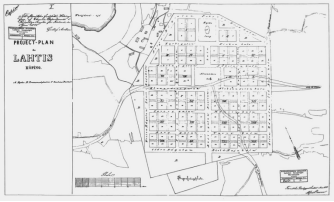
In the early 1920s the city gained possession of the grounds of the Lahti Manor, an important piece of land previously blocking the city from the lake. Large-scale industrial operations grew rapidly in the 1930s as did the population; Lahti, at the time, was one of Finland's fastest-growing cities, and before the start of the Winter War its population was approaching 30,000.
Through the addition of new areas in 1924, 1933 and 1956, Lahti grew, both in terms of population and surface area. Especially strong was the growth after the Wars, when Lahti accepted about 10,000 immigrants from Karelia, after the region was surrendered to the Soviet Union, and then later in the 1960s and 1970s as a result of mass urbanization. The rapid population growth came to a sharp end in 1975 and the city has since grown clearly slower albeit Mostly steadily, with the latest notable growth in population happening in 2016 when the municipality of Nastola became a part of Lahti.
In December 2018 Lahti became the first new university city in Finland after Rovaniemi in 1979 when the Parliament adopted a change in the university law. LUT University nowadays consists of two campuses, Lappeenranta and Lahti.
2. 文化体育
Lahti Harbors cultural ambitions, manifested notably in the construction of a large Congress and concert center, the Sibelius Hall (2000) by Architects Kimmo Lintula and Hannu Tikka. Lahti has one of Finland's most widely known Symphony Orchestras, the Lahti Symphony Orchestra (Sinfonia Lahti), based at the Sibelius Hall, which performs both Classical and popular music, notably concentrating on music by Jean Sibelius. The Orchestra has won several well-respected international prizes.
Lahti's annual music festival program includes such events as the Lahti Organ Festival, a jazz festival held in the city's market square and the Sibelius Festival. In addition to the Sibelius Hall, other additional notable works of architecture in Lahti are the City Hall (1911) by Eliel Saarinen, the Church of the Cross (1978) by Alvar Aalto, Nastola Church (1804), the oldest church in the city , the City Theater (1983) by Pekka Salminen, the City Library (1990) by Arto Sipinen, the Piano Pavilion (2008) by Gert Wingårdh, and the Travel Center (2016) by JKMM Architects. The City of Lahti has also acted as the host city for the international Spirit of Wood Architecture Award, established in Finland in 1999. Some of the Prize-winners have received Commissions to design small structures in the city; these include small works by Japanese architect Kengo Kuma and Australian architect Richard Leplastrier.
Lahti has a rich sporting tradition, especially in various wintersports. The city is well known for the annually held Lahti Ski Games and the Finlandia cross-country skiing contest. It is also the only city to host the FIS Nordic World Ski Championships seven times, doing so in 1926, 1938, 1958, 1978, 1989, 2001 and 2017.
he Pelicans have competed in the top level of Finnish ice hockey, the League, since 1999. Before the new Millennium Reipas represented Lahti in top-flight hockey for 50 years. Many former NHL players, such as Janne Laukkanen, Toni Lydman and Pasi Nurminen, have started their Careers in Reipas.
Historically the city's most successful association football club has been Kuusysi. In their golden years lasting from the early 1980s to the 1990s they won five Finnish Championships as well as two Finnish Cup titles, with Appearances in European competitions each year. Their Greatest rivals, Reipas, won a total of three Championships and seven cup titles from 1963 to 1978 but diminished in the early 1980s as Kuusysi got Stronger.
In the 1990s both clubs ended up in such massive financial difficulties that a Merger was executed in 1996, with the newly formed club adopting a new name, crest and colors. FC Lahti has played in the Veikkausliiga since 1999, excluding a season-long visit to the first division in 2011, having placed twice third and appearing in Europe three times.
The 1997 World Games and the 2009 World Masters Athletics Championships were held in Lahti. For the 1952 Summer Olympics, some of the football matches were played at Kisapuisto.
七、其他信息
There are three ports on the shores of Lake Vesijärvi in Lahti: Vesijärvi Harbor, Teiva Marina and Niemi Marina. There are cultural activities in Vesijärvi harbor, including performances by Vesijärvi harbor warehouse and Sibelius Hall, as well as restaurant ships. The port of Vesijärvi is also often referred to as the port of Lahti.
八、联系方式
Town manager: Pekka Timonen
Phone:+358381411
Email:etunimi.sukunimi@lahti.fi
Address:PL 202, 15101 Laht
https://www.lahti.fi
